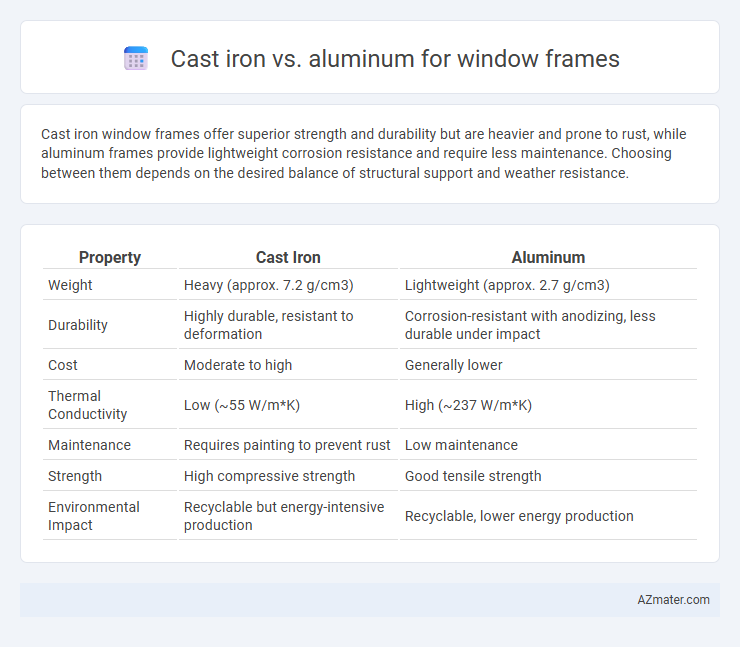Cast iron window frames offer superior strength and durability but are heavier and prone to rust, while aluminum frames provide lightweight corrosion resistance and require less maintenance. Choosing between them depends on the desired balance of structural support and weather resistance.
Table of Comparison
| Property | Cast Iron | Aluminum |
|---|---|---|
| Weight | Heavy (approx. 7.2 g/cm3) | Lightweight (approx. 2.7 g/cm3) |
| Durability | Highly durable, resistant to deformation | Corrosion-resistant with anodizing, less durable under impact |
| Cost | Moderate to high | Generally lower |
| Thermal Conductivity | Low (~55 W/m*K) | High (~237 W/m*K) |
| Maintenance | Requires painting to prevent rust | Low maintenance |
| Strength | High compressive strength | Good tensile strength |
| Environmental Impact | Recyclable but energy-intensive production | Recyclable, lower energy production |
Introduction to Window Frame Materials
Cast iron and aluminum are two common materials used for window frames, each offering distinct advantages in durability and design. Cast iron provides exceptional strength and a classic aesthetic, making it ideal for historic or heavy-duty applications, while aluminum is valued for its lightweight nature, corrosion resistance, and modern appeal. Understanding the properties of cast iron and aluminum helps in selecting window frames that balance structural performance with architectural style.
Overview of Cast Iron Window Frames
Cast iron window frames are renowned for their exceptional strength, durability, and timeless aesthetic appeal, often used in historic and high-end construction. These frames offer superior resistance to weathering, corrosion, and structural deformation compared to aluminum. Their heavy weight and high thermal mass contribute to enhanced insulation and noise reduction, making cast iron a premium choice for long-lasting window installations.
Overview of Aluminum Window Frames
Aluminum window frames offer exceptional durability and resistance to corrosion, making them ideal for various climates and weather conditions. Their lightweight nature allows for larger window openings and slimmer profiles, enhancing natural light and aesthetic appeal. High thermal efficiency options are available with thermal breaks, improving energy performance compared to traditional metal frames.
Strength and Durability Comparison
Cast iron window frames offer superior strength and exceptional durability, resisting deformation and providing long-lasting structural stability in harsh weather conditions. Aluminum frames, while lighter and corrosion-resistant, lack the robust load-bearing capacity of cast iron and may require additional treatments to enhance their lifespan. In applications demanding maximum strength and endurance, cast iron remains the preferred choice due to its ability to withstand impact and wear over extended periods.
Thermal Conductivity and Insulation
Cast iron window frames have low thermal conductivity, around 55 W/m*K, which results in stronger heat retention but poorer insulation compared to aluminum. Aluminum frames exhibit high thermal conductivity, approximately 205 W/m*K, causing significant heat transfer and necessitating thermal breaks to improve energy efficiency. Proper insulation techniques are critical for aluminum frames to reduce thermal bridging and enhance indoor temperature regulation.
Maintenance Requirements
Cast iron window frames demand regular maintenance including rust prevention treatments such as painting or sealing to combat corrosion and prolong lifespan. Aluminum frames require minimal upkeep due to their inherent resistance to rust and corrosion, though occasional cleaning to remove dirt and debris is recommended. Choosing aluminum reduces long-term maintenance efforts and costs compared to cast iron.
Aesthetic Versatility
Cast iron window frames offer classic, ornate designs with intricate detailing that enhances historic and traditional architectural styles. Aluminum frames provide sleek, modern aesthetics with clean lines and can be easily powder-coated in various colors for customization. The choice between cast iron and aluminum depends on the desired architectural style and level of design flexibility needed.
Environmental Impact and Sustainability
Cast iron window frames have a higher environmental impact due to energy-intensive production and limited recyclability compared to aluminum, which is highly recyclable and requires less energy during manufacturing. Aluminum frames offer superior sustainability benefits through their lightweight nature, reducing transportation emissions and allowing for easier reuse and recycling at the end of their lifecycle. Choosing aluminum over cast iron for window frames supports reduced carbon footprints and aligns with eco-friendly building practices.
Cost Analysis: Cast Iron vs. Aluminum
Cast iron window frames typically have higher initial costs due to their heavy material and complex manufacturing processes, whereas aluminum frames offer a more budget-friendly option with lower production expenses. Long-term maintenance costs for cast iron can be significant, considering its susceptibility to rust and the need for regular painting, while aluminum requires minimal upkeep due to corrosion resistance. When evaluating overall cost-effectiveness, aluminum frames generally present a better economic investment for window framing projects given their affordability and longevity.
Choosing the Right Material for Your Window Frames
Cast iron window frames offer exceptional strength, durability, and timeless architectural appeal, making them ideal for historic or heavy-duty applications, while aluminum frames provide lightweight, corrosion-resistant, and low-maintenance options suitable for modern designs and energy-efficient windows. The thermal conductivity of aluminum is higher, which may require thermal breaks to improve insulation, whereas cast iron naturally retains heat better but can be prone to rust without proper treatment. Selecting the right material depends on climate, aesthetic preferences, maintenance willingness, and budget considerations to ensure long-lasting performance and energy efficiency.

Infographic: Cast iron vs Aluminum for Window frame
 azmater.com
azmater.com